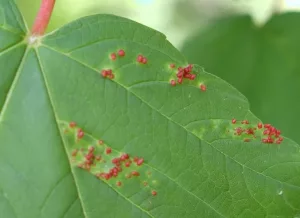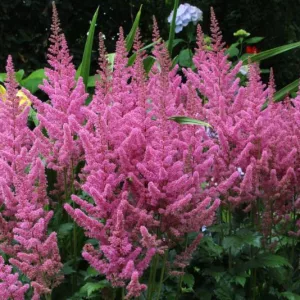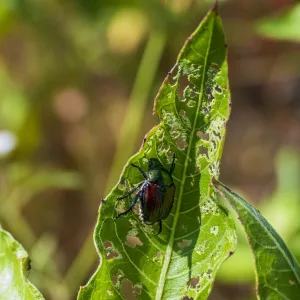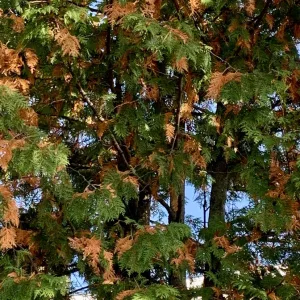Wondering about about red ‘pimples’ on maple leaves? The culprit causing that damage can be either a bladder gall mite or spindle gall mite. The leaf reacts to the attack by forming a small raised growth that the mite then lays eggs in. The growth starts out green and later changes to red.
Our native red maple tree is particular susceptible to attack from gall mites. Although the leaves look unsightly, no real damage is done to the tree. Well-established, healthy red maples are less susceptible to gall mites, and will suffer less damage.
If your tree is young, of a size that control measures may work, a few things can be done to reduce the population of gall mites. First of all, on an early spring day while the tree is still dormant, spray the bark and stems with lime sulphur. It is an effective miticide.
Be sure to spray when it’s a mild day, when temperatures aren’t predicted to drop below zero. As well, protect other nearby plants that aren’t still dormant and hard surfaces from spray residue.
I often recommend dormant oil as a solution for insects that overwinter on trees, but its not recommend here as the oil make cause damage to red maples.
You can also prune out the affected leaves when you do see galls beginning to form. Be sure to bag up everything you prune, being careful not to put leaves into a compost pile.
Another garden problem that that is showing up in many vegetable gardens is the damaged cause by the cabbage moth larvae. This white moth lays eggs on the leaves of cabbage plants as well as other members of this family, broccoli, Brussel sprouts, and cauliflower to name a few.
Once the larvae hatch, they begin to feed on new growth and leaves. When you see damage starting, be sure to look closely at plants as the larvae are the colour of the leaves, so often hard to spot. You can hand pick the larvae and squish them, or if squeamish, drop them into a container of soapy water/rubbing alcohol mixture. Keep a sharp eye out, as there can be several generations of this pest per season.
You can also safety spray vegetable plants with the biological insecticide Btk. It is safe to use right up to the day of harvest. Unfortunately, as with many items in short supply during Covid-19 times, Btk is hard to find right now.
If you research other spays to control this pest, you will find reference to using neem oil. Garden centres are no longer allowed to offer this product for sale as it’s not register as an insecticide in Canada.
A good preventive measure for the cabbage moth and its larvae for next season would be to have some floating row cover on hand. You can set out a frame of hoops and lay the cover over your crop. This will help to prevent the month from being able to lay eggs on your plants. Just be sure to secure the cover all around so the months can’t get in.




